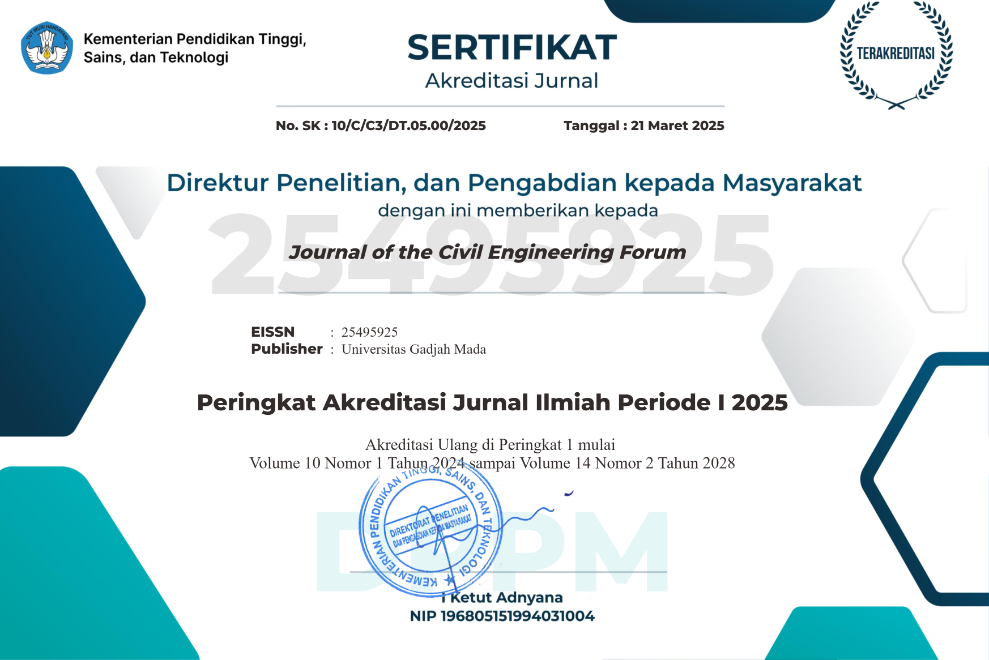Debris Flow Detection by Combinations of LVP Sensors and Wires: Examples in Sakura-jima Island in Japan
Abstract
Various kinds of sensors for debris flows detection have been proposed such as wire sensor, acceleration sensor, and so on. In Europe, a geophone that is based on a vibration meter is usually used though the applicability is not confirmed for debris flow detection in Japan. A wire sensor is still currently used for debris flow detection in Japan, because of its easy maintenance and measurement principle of disconnected wires. However, there is a drawback in that debris flow cannot be detected until manual maintenance is performed after the wires are disconnected. Sakura-jima is in southwest of Japan. Debris flows occur by rainfall and ash fall after eruption. Many debris flows occur and transport sediment by debris flow events. The number of debris flow occurrences is defined by the number of disconnected wires from a wire sensor, and three wires are set vertically at the height of 60 cm, 120 cm, 180 cm from the bed, respectively, to know magnitude of debris flow height. A LVP sensor has been developed and installed there for continuous detection of debris flows and modified based on technical information obtained by maintenance after debris flow events. The sensor consists of load cell (L), acceleration meter due to vibration (V) and pressure meter (P). The sensor is mainly for debris flow detection, though weight of debris flows on the bed is attempted to be measured using a small box with loadcell. Present studies introduce some examples of debris flow detections using the LVP and emphasize usage of the LVP sensor in combination with wires.
References
Arattano, M. and Marchi, L. (2008), ‘Systems and sen-sors for debris-flow monitoring and warning’,Sensors8, 2436–2452. URL:https://www.mdpi.com/1424-8220/8/4/2436
Coviello, V. (2023), ‘Debris-flow detection for earlywarning purposes: recent advances, open prob-lems, and future challenges’,E3S Web of Conferences415, 03007. URL:https://doi.org/10.1051/e3sconf/202341503007
Ersoz, T. and Gonda, Y. (2024), ‘Investigation of differ-ent lahar types with rainfall intensity duration curvesin arimura river basin of sakurajima volcano’,Interna-tional Journal of Erosion Control Engineering17(1). URL:https://doi.org/10.13101/ijece.17.1
Gonda, Y., Miyata, S., Fujita, M., Legono, D. andTsutsumi, D. (2019), ‘Temporal changes in runoffcharacteristics of lahars’,Journal of Disaster Research14(1), 62–68. URL:https://doi.org/10.20965/jdr.2019.p0061
Hambali, R., Legono, D., Jayadi, R. and Oishi, S. (2019),‘Improving spatial rainfall estimates at mt. merapi areausing radar-rain gauge conditional merging’,Journal ofDisaster Research14(1), 69–79. URL:https://doi.org/10.20965/jdr.2019.p0069
Harsanto, P., Ikhsan, J., Legono, D., Rahardjo, A. P.and Tsutsumi, D. (2020), ‘Sediment transport pre-measurement as revealed by the hydrophone monitor-ing technique at a volcanic river’,IOP Conference Series:Earth and Environmental Science437, 012050. URL:https://doi.org/10.1088/1755-1315/437/1/012050
Ikhsan, J., Fujita, M. and Takebayashi, H. (2010), ‘Sedi-ment disaster and resource management in the mountmerapi area, indonesia’,International Journal of ErosionControl Engineering3(1), 43–52. URL:https://doi.org/10.13101/ijece.3.43
Itoh, T., Iwao, T., Kubo, S., Tsurumoto, T., Tagata, S.,Furuya, M. and Mizuyama, T. (2023), ‘Continuous de-bris flow monitoring using dvlp and lvp on sakura-jimaisland’,E3S Web of Conferences415, 03015. URL:https://doi.org/10.1051/e3sconf/202341503015
Itoh, T., Mizuyama, T. and Tagata, S. (2017), Direct de-bris flow monitoring using load cell systems in saku-rajima island,in‘Proceedings of the 37th IAHR WorldCongress’, Kuala Lumpur, Malaysia, pp. 1142–1150. URL:https://www.iahr.org/library/info?pid=2582
Johnson, J. B., Roca, A., Pineda, A., Merida, R., Escobar-Wolf, R.,Anderson, J. F., Mock, J., Bosa,A., Bejar, G. andWaite, G. P. (2023), ‘Infrasound detection of approach-ing lahars’,Scientific Reports13, 6476. URL:https://doi.org/10.1038/s41598-023-32109-2
Kato, H., Noda, N., Hashi, K., Tagata, S., Itoh, T. andMizuyama, T. (2018), Debris flow detection usinglvp sensors in japan,inT. e. a. Yamada, ed., ‘IN-TERPRAEVENT 2018 in the Pacific Rim, SymposiumProceedings (DVD)’, Toyama, Japan, pp. 355–362. URL:https://www.interpraevent.at/palm-cms/upload_files/Publikationen/Tagungs-beitraege/2018_1_355.pdf
McArdell, B. W., Perry, B. and Julia, K. (2007), ‘Fieldobservations of basal forces and fluid pore pressure ina debris flow’,Geophysical Research Letters34, L07406,1–4. URL:https://agupubs.onlinelibrary.wi-ley.com/doi/full/10.1029/2006GL029183
Mizuyama, T., Fujita, M. and Nonaka, M. (2003), Mea-surement of bedload with the use of hydrophones inmountain torrents,in‘Proceeding of Oslo Workshopon Erosion and Sediment Transport Measurement inRivers: Technological and Methodological Advances,IAHS Publication’, Vol. 283, pp. 222–227. URL:https://iahs.info/uploads/dms/iahs283222.pdf
Mizuyama, T., Hirasawa, R., Kosugi, K., Tsutsumi, D.and Nonaka, . (2011), ‘Sediment monitoring with a hy-drophone in mountain torrents’,International Journalof Erosion Control Engineering4(2), 43–47. URL:https://doi.org/10.13101/ijece.4.43
Osaka, T., Utsunomiya, R., Tagata, S., Itoh, T. andMizuyama, T. (2014), Debris flow monitoring usingload cells in sakurajima island,in‘Interpraevent 2014Pacific Rim (edited by Fujita, M. et al.)’, Nara, Japan,pp. O–14.pdf in DVD. URL:https://www.interpraevent.at/palm-cms/upload_files/Publikationen/Tagungs-beitraege/2014_1_107.pdf
Osumi Construction Office in the Ministry of Construc-tion (1988),Debris flow in Sakura-jima Island, SABOPublicity Center. (in Japanese).
Osumi Office of River and Highway in the Ministry ofLand (2013),Technical report of Sabo research related tovolcanic activity in Sakura-jima Island (2), SABO Public-ity Center. (in Japanese).
Scott, W. M., Coe, J. A., Kean, J. W., Turker, G. E., Sta-ley, D. M. and Wasklewicz, T. A. (2011), ‘Observationsof debris flows at chalk cliffs, colorado, usa: Part 1’,Italian Journal of Engineering Geology and Environment1, 65–75.URL:https://pubs.usgs.gov/publication/70003928
Ye, J., Kurashima, Y., Kobayashi, ., Tsuda, H., Takahara,T. and Sakurai, W. (2019), ‘An efficient in-situ debrisflow monitoring system over a wireless accelerometernetwork’,Remote Sensing11(1512).URL:https://doi.org/10.3390/rs11131512
Yin, H. Y., Huang, C. J., Fang, Y. M., Lee, B. J. and Chou,T. Y. (2015), ‘The present development of debris flowmonitoring technology in taiwan - a case study presen-tation’,Italian Journal of Engineering Geology and Envi-ronmentpp. 623–631.URL:https://doi.org/10.4408/IJEGE.2011-03.B-06831
Copyright (c) 2024 The Author(s)

This work is licensed under a Creative Commons Attribution-ShareAlike 4.0 International License.
Copyright is granted to authors for the purpose of providing protection for articles written to describe experiments and their results. JCEF will protect and defend the work and reputation of the author and are also willing to address any allegations of violation, plagiarism, fraud, etc. against articles written and published by JCEF. JCEF is published under the terms of the Creative Commons Attribution-ShareAlike 4.0 International License (CC BY-SA 4.0). The author holds the copyright and assigns the journal rights to the first publication (online and print) of the work simultaneously.







